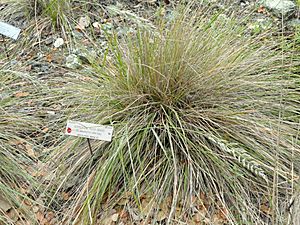Serpentine reedgrass facts for kids
Quick facts for kids Serpentine reedgrass |
|
|---|---|
 |
|
| Scientific classification | |
| Genus: |
Calamagrostis
|
| Species: |
ophitidis
|
The Calamagrostis ophitidis, also known as the serpentine reedgrass, is a type of bunch grass. It belongs to the Poaceae family, which is the scientific name for the grass family.
This special grass is found only in California. It grows in unique soils called serpentine soils, which are found on mountain slopes north of the San Francisco Bay Area.
What is Serpentine Reedgrass?
Serpentine reedgrass is a perennial plant. This means it lives for more than two years and grows back each spring without needing to be replanted. It forms dense clumps, like a small bush of grass, and can grow to be about 60 centimeters (about 2 feet) to one meter (about 3 feet) tall.
The plant's flowers, which are called the inflorescence, look like a thin, bushy group of pale-colored spikelets. Spikelets are small clusters of flowers that are typical for grasses.
Where Does It Grow?
This grass is an endemic species, meaning it naturally grows in only one specific area. For the serpentine reedgrass, that area is California. It is especially adapted to live in serpentine soil.
Serpentine soil is a special type of soil that forms from rocks rich in minerals like magnesium and iron. This soil often has low levels of nutrients that most plants need, and sometimes it has high levels of metals that can be toxic to other plants. However, serpentine reedgrass has evolved to thrive in these challenging conditions, making it a unique part of California's plant life.
See also
 In Spanish: Calamagrostis ophitidis para niños
In Spanish: Calamagrostis ophitidis para niños

